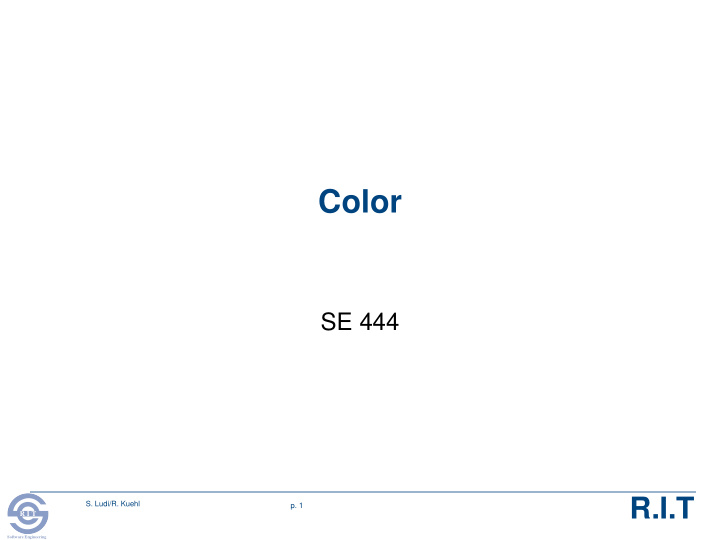



Color SE 444 R.I.T S. Ludi/R. Kuehl p. 1 R I T Software Engineering
Color Topics Color perception Using color in interaction design Color concerns for interaction design Color Reference R.I.T S. Ludi/R. Kuehl p. 2 R I T Software Engineering
Color Perception - A Physics Review A light source emits light waves at visible frequencies that strike an object The object absorbs and or reflects different frequencies The object may be opaque, transparent, or translucent The reflected frequencies determine the object’s color Black if all frequencies absorbed White if all frequencies reflected Other combinations produce the color spectrum The perceived color varies based on light source properties and viewing conditions R.I.T S. Ludi/R. Kuehl p. 3 R I T Software Engineering
Color Systems Primary colors – basic colors from which all other colors are derived Light – Red, Green, Blue (RGB) Print – Cyan, Magenta, Yellow and (Black) R.I.T S. Ludi/R. Kuehl p. 4 R I T Software Engineering
Color Perception The human visual system (rods and cones) The cones prevalent in the central retina are sensitive to color Sensitive to red, green, and blue The rods prevalent on the retina periphery are sensitive to motion and low-light environments Visual limitations Color perception is weak in our peripheral vision Eyes are most sensitive to the middle frequencies, green and yellow R.I.T S. Ludi/R. Kuehl p. 5 R I T Software Engineering
Color Deficiencies Photoreceptors vary greatly from person to person People with photoreceptors that do not respond to certain frequencies do not perceive those colors in the same way that other people do; “color blindness” 8% of male individuals 0.4% of female individuals The most common form is a reduced sensitivity to green, known as deuteranomaly 5% of male individuals 95% of color deficiencies in female individuals R.I.T S. Ludi/R. Kuehl p. 6 R I T Software Engineering
Types of Color Blindness Protanopic color vision, no Deuteranopic color vision, Normal ability to perceive red no ability to perceive green trichromatic color vision Deuteranopic Normal Color Blindness Simulator R.I.T S. Ludi/R. Kuehl p. 7 R I T Software Engineering
Color Perception Factors affecting color perception: Culture Age Fatigue Emotions Ambient light Light sources Blood oxygen levels Color can evoke: An expectation, preferences Emotion – aesthetic appeal – “ warm ” versus “ cold ” colors Localization – differences by culture or commercial context (logo color) in the meaning and emotion of color R.I.T S. Ludi/R. Kuehl p. 8 R I T Software Engineering
Using Color in Interaction Design Clarification, Relation, and Differentiation Searching Comprehension, Retention, and Recall Task Performance Redundant Coding Color Concerns for Interaction Design R.I.T S. Ludi/R. Kuehl p. 9 R I T Software Engineering
Clarification, Relation, and Differentiation Color can be used to clarify differences and similarities and communicate relationships Color codes can be used to support a logical information structure; e.g., multi-variable graph R.I.T S. Ludi/R. Kuehl p. 10 R I T Software Engineering
Searching Color can be used to catch the attention of the user Keywords, string types R.I.T S. Ludi/R. Kuehl p. 11 R I T Software Engineering
Comprehension, Retention, and Recall Color can enable us to comprehend patterns in complex data structures Scatter Plot Color can aid in remembering and recalling information R.I.T S. Ludi/R. Kuehl p. 12 R I T Software Engineering
Task Performance and Redundancy Studies show color improves task performance for: Recall Search-and-locate Retention Decision judgment Redundancy – color alone is not enough A clear HCI structure and presentation must already be present before color is introduced Use multiple sensory cues (e.g. color and shape) Don’t use color to delineate shapes – contrast issues R.I.T S. Ludi/R. Kuehl p. 13 R I T Software Engineering
Color Concerns for Interaction Design Limitations in the perception of subtle color differences Number and choice of colors To aid in color recognition and recall, use only a few distinct colors Red, green, blue, and yellow are best Five to nine colors for coding information Don’t distract the user or compete with content Keep color perception limitations in mind E.g., we see green and yellow best, so avoid small blue objects Avoid saturated colors – can cause visual fatigue R.I.T S. Ludi/R. Kuehl p. 14 R I T Software Engineering
Color Concerns - Contrast Incompatible differences Saturated yellow and green Saturated yellow on green - some specific color Yellow on white Yellow on white combinations cause Blue on black Blue on black unique problems: Green on white Green on white Colors at opposing ends Saturated red on blue Saturated red on blue of the spectrum such as red and blue Saturated red on green Saturated red on green Positive contrast makes Magenta on green Magenta on green characters appear to glow Saturated blue on green Saturated blue on green (Halation) Yellow on purple Yellow on purple Red on black Red on black Magenta on black Magenta on black R.I.T S. Ludi/R. Kuehl p. 15 R I T Software Engineering
Foreground-Background Color Contrast Color Backgrounds An object’s perceived color is affected by the background color R.I.T S. Ludi/R. Kuehl p. 16 R I T Software Engineering
Recommend
More recommend